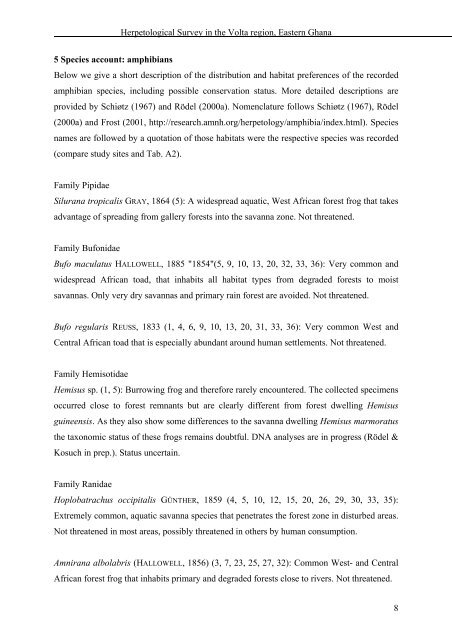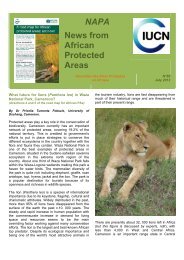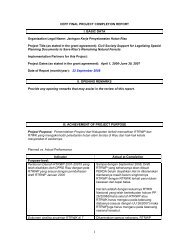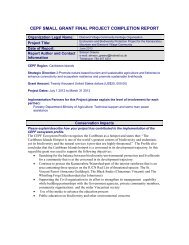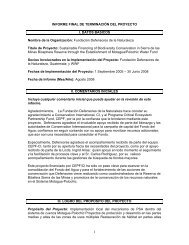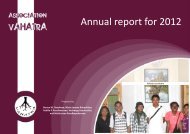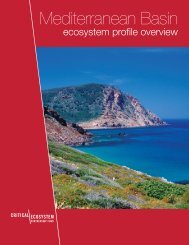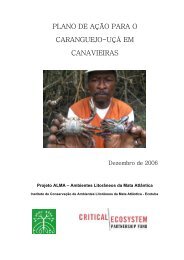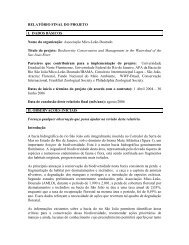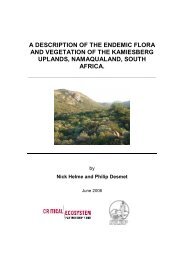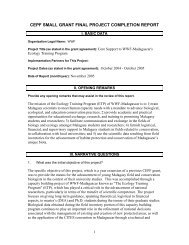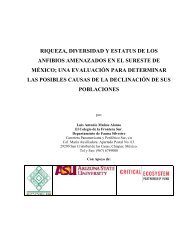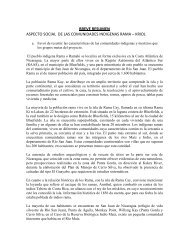Herpetological survey in the Volta region, Eastern Ghana - Critical ...
Herpetological survey in the Volta region, Eastern Ghana - Critical ...
Herpetological survey in the Volta region, Eastern Ghana - Critical ...
Create successful ePaper yourself
Turn your PDF publications into a flip-book with our unique Google optimized e-Paper software.
<strong>Herpetological</strong> Survey <strong>in</strong> <strong>the</strong> <strong>Volta</strong> <strong>region</strong>, <strong>Eastern</strong> <strong>Ghana</strong><br />
5 Species account: amphibians<br />
Below we give a short description of <strong>the</strong> distribution and habitat preferences of <strong>the</strong> recorded<br />
amphibian species, <strong>in</strong>clud<strong>in</strong>g possible conservation status. More detailed descriptions are<br />
provided by Schiøtz (1967) and Rödel (2000a). Nomenclature follows Schiøtz (1967), Rödel<br />
(2000a) and Frost (2001, http://research.amnh.org/herpetology/amphibia/<strong>in</strong>dex.html). Species<br />
names are followed by a quotation of those habitats were <strong>the</strong> respective species was recorded<br />
(compare study sites and Tab. A2).<br />
Family Pipidae<br />
Silurana tropicalis GRAY, 1864 (5): A widespread aquatic, West African forest frog that takes<br />
advantage of spread<strong>in</strong>g from gallery forests <strong>in</strong>to <strong>the</strong> savanna zone. Not threatened.<br />
Family Bufonidae<br />
Bufo maculatus HALLOWELL, 1885 "1854"(5, 9, 10, 13, 20, 32, 33, 36): Very common and<br />
widespread African toad, that <strong>in</strong>habits all habitat types from degraded forests to moist<br />
savannas. Only very dry savannas and primary ra<strong>in</strong> forest are avoided. Not threatened.<br />
Bufo regularis REUSS, 1833 (1, 4, 6, 9, 10, 13, 20, 31, 33, 36): Very common West and<br />
Central African toad that is especially abundant around human settlements. Not threatened.<br />
Family Hemisotidae<br />
Hemisus sp. (1, 5): Burrow<strong>in</strong>g frog and <strong>the</strong>refore rarely encountered. The collected specimens<br />
occurred close to forest remnants but are clearly different from forest dwell<strong>in</strong>g Hemisus<br />
gu<strong>in</strong>eensis. As <strong>the</strong>y also show some differences to <strong>the</strong> savanna dwell<strong>in</strong>g Hemisus marmoratus<br />
<strong>the</strong> taxonomic status of <strong>the</strong>se frogs rema<strong>in</strong>s doubtful. DNA analyses are <strong>in</strong> progress (Rödel &<br />
Kosuch <strong>in</strong> prep.). Status uncerta<strong>in</strong>.<br />
Family Ranidae<br />
Hoplobatrachus occipitalis GÜNTHER, 1859 (4, 5, 10, 12, 15, 20, 26, 29, 30, 33, 35):<br />
Extremely common, aquatic savanna species that penetrates <strong>the</strong> forest zone <strong>in</strong> disturbed areas.<br />
Not threatened <strong>in</strong> most areas, possibly threatened <strong>in</strong> o<strong>the</strong>rs by human consumption.<br />
Amnirana albolabris (HALLOWELL, 1856) (3, 7, 23, 25, 27, 32): Common West- and Central<br />
African forest frog that <strong>in</strong>habits primary and degraded forests close to rivers. Not threatened.<br />
8


